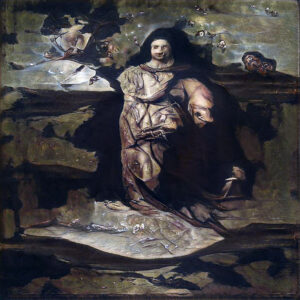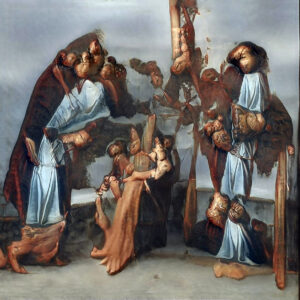The Kiss of Judas by Joan Fontcuberta, a historical essay that marked the watershed between the alleged truth of photography and the fake, has recently been translated also in Italy. Déjà vu, his latest exhibition built together with Pilar Rosado Rodrigo, after the Arles festival is on display until 22 October 2022 at the Grenze Contemporary Gallery in Verona. We invited the Catalan scholar to reflect with us on the role of photography in narrating reality.
Simone Azzoni: Why can we no longer trust photography?
Joan Fontcuberta: The problem is that we raised the question of trust in photography and not in the photographer. Language never gives us guarantees in this sense; on the contrary, it is constricting because it encapsulates the way of expressing the experience. Today we understand that, even assuming that the photograph is neutral, the accent should fall on the subject.
Since the 1996 edition of the Arles festival dedicated to doubt and disenchantment, how has photography changed today with respect to its potential to change the behavior of the beholder?
The evolution of photography has led to the collapse of its ideological framework, which in summary rested on the values of truth and memory. But the most important thing is the visual education of today’s public, largely “digital natives”, who have become familiar with the malleability of the image and deprived photography of its sacrosanct aura. With mobile phones, photography has become a language that we use naturally.
Photography lies by instinct and by nature, therefore it should be art in all respects, yet how hard it is to get it into the art system…
Since Duchamp, art has never ceased to pose problems. Today, artistic practice no longer pursues a purpose of originality and expression, but expands into deliberately anti-artistic domains, and photography has no doubt contributed to this process. You have to be very careful. I like the Duchampian notion of “inframince”: the most genuine art is characterized by its lightness: just by talking about it, it already disappears.
The contemporary system, as you demonstrate in The Kiss of Judas, when you talk about the use that dictators make of the image, destroys the possibility of photography to document.
We check this daily with the widespread implementation of post-truths and fake news. In the 1930s, when the idea of documentary photography for social emancipation programs emerged, authors like Margaret Bourke-White were already wondering if it was possible to go beyond propaganda, if objectivity was nothing more than a naive myth and therefore it should simply prevail to put oneself at the service of a “good” cause.
The pact of truthfulness has been betrayed, but there do not seem to be any others on the horizon. What do you think?
The agreements last as long as there is a harmony of interests among those who signed them. We live in another era. We could say that the blindfold that covered our eyes has fallen, but the reality is that today’s protagonists need other, less dogmatic, agreements.
We all know that photography can be manipulated, but why don’t we reflect on the manipulability of photography?
Photography has a protein nature but many cultural conventions have presented it to us as a literal, unique and immovable transcription of reality. Photography has been the victim of a certain intellectual authoritarianism. Today, every child who plays with Instagram filters knows that photography is malleable and laughs at its supposed literality.
Can you give us an example of a good use of photography and a bad one?
For this, it is necessary to verify the correspondence between the intention and the result. Unfortunately, we can often only guess what the intention was. For example, think about Pete Souza’s photo of Obama, Hillary Clinton and the entire White House crisis cabinet watching on a monitor the Navy Seals commando assassinating Bin Laden. If the goal of that photo was to cap complete visual information, it has been achieved and it has been a good use. If the intention was to provide transparent and democratic information, it was an improper use.
The context gives truth to photography, as you demonstrated for example through your experiments on Natural Museums, in which you exhibit absolutely “fake” images alongside scientific artifacts that refer to monstrous creatures. Can you remove the context and leave photography without imagery or can you just question it?
All photos are waiting for a (con)text. Photography itself is an abstract mix of shapes, colors and textures, which acquire meaning for us only when we access the “metados” provided by the context. Decontextualizing a photograph is a surreal act similar to “objet-trouvé”, as it was demonstrated by Mike Mandel and Larry Sultan with their book “Evidence”.
We can still talk about beautiful photography or will it be necessary to convert the judgment on its function?
Quality usually refers to the domain of aesthetics, but function is more important to me: how we use images and what they are for. Generally we could say that they are useful for egotiating our models of reality and therefore they contribute to forging our judgments. I like to support a photograph “without quality” so as not to distract us from the formal, tactical aspects and speak instead of aims and effects, that is strategic aspects.
Is it still possible to play cleanly with the images? Unmasking the power and some bullying? A resurrection after a betrayal kiss?
My hope is to try to delete and regenerate the images. The key, however, lies in the visual culture of the public, in encouraging responsive and not submissive attitudes. We image producers have a responsibility in this sense, we must help promote critical thinking.
Info:
 Joan Fontcuberta y Pilar Rosado, DÉJÀ-VU, 2022, courtesy the artist and Grenze Contemporary Gallery
Joan Fontcuberta y Pilar Rosado, DÉJÀ-VU, 2022, courtesy the artist and Grenze Contemporary Gallery
 Joan Fontcuberta y Pilar Rosado, DÉJÀ-VU, 2022, courtesy the artist and Grenze Contemporary Gallery
Joan Fontcuberta y Pilar Rosado, DÉJÀ-VU, 2022, courtesy the artist and Grenze Contemporary Gallery
 Joan Fontcuberta y Pilar Rosado, DÉJÀ-VU, 2022, courtesy the artist and Grenze Contemporary Gallery
Joan Fontcuberta y Pilar Rosado, DÉJÀ-VU, 2022, courtesy the artist and Grenze Contemporary Gallery
 Joan Fontcuberta y Pilar Rosado, DÉJÀ-VU, 2022, installation view at Grenze Contemporary Gallery
Joan Fontcuberta y Pilar Rosado, DÉJÀ-VU, 2022, installation view at Grenze Contemporary Gallery

He is an art critic and professor of Contemporary Art History at IUSVE. He also teaches Critical Image Reading at the Palladio Institute of Design in Verona and Contemporary Art at the Master of Publishing at the University of Verona. He has curated several contemporary art exhibitions in unconventional places. He is the artistic director of the Grenze Photography Festival. He is a theater critic for national magazines and newspapers. He organizes research and experimentation theatrical events. Among the recent publications Frame – Videoarte e dintorni for the University Library, Lo Sguardo della Gallina for Lazy Dog Editions and for Mimemsis Smagliature in 2018 and 2021 for the same publishing house, Theater and photography.






NO COMMENT